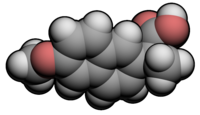Naproxen sodium
 |
|
 |
|
| Clinical data | |
|---|---|
| Pronunciation | /nəˈprɒksən/ |
| Trade names | Aleve, Anaprox, Naprelan, Naprosyn, other |
| AHFS/Drugs.com | Monograph |
| MedlinePlus | a681029 |
| License data | |
| Pregnancy category |
|
| Routes of administration |
Oral. |
| ATC code | G02CC02 (WHO) M01AE02 (WHO), M02AA12 (WHO) |
| Legal status | |
| Legal status |
|
| Pharmacokinetic data | |
| Bioavailability | 95% (oral) |
| Protein binding | 99% |
| Metabolism | Hepatic (to 6-desmethylnaproxen) |
| Biological half-life | 12–24 hours |
| Excretion | Renal |
| Identifiers | |
|
|
| CAS Number |
22204-53-1 |
| PubChem (CID) | 156391 |
| DrugBank |
DB00788 |
| ChemSpider |
137720 |
| UNII |
57Y76R9ATQ |
| KEGG |
D00118 |
| ChEBI |
CHEBI:7476 |
| ChEMBL |
CHEMBL154 |
| ECHA InfoCard | 100.040.747 |
| Chemical and physical data | |
| Formula | C14H14O3 |
| Molar mass | 230.259 g/mol |
| 3D model (Jmol) | Interactive image |
| Melting point | 152–154 °C (306–309 °F) |
|
|
|
|
Naproxen (brand names: Aleve, Naprosyn, and many others) is a nonsteroidal anti-inflammatory drug (NSAID) of the propionic acid class (the same class as ibuprofen) that relieves pain, fever, swelling, and stiffness. It is a nonselective COX inhibitor, usually sold as the sodium salt.
Naproxen poses an intermediate risk of stomach ulcers compared to ibuprofen, which is low-risk, and indometacin, which is high-risk. To reduce stomach ulceration risk, it is often combined with a proton-pump inhibitor (a medication that reduces stomach acid production) during long-term treatment of those with pre-existing stomach ulcers or a history of developing stomach ulcers while on NSAIDs.
Naproxen is commonly used to reduce pain, fever, inflammation, and stiffness caused by conditions such as migraine, osteoarthritis, kidney stones, rheumatoid arthritis, psoriatic arthritis, gout, ankylosing spondylitis, menstrual cramps, tendinitis, and bursitis. It is also used to treat primary dysmenorrhea.
Naproxen is used as a "bridge therapy" in medication-overuse headache to transition patients off of other medications.
Naproxen has been used to differentiate between infectious fevers and neoplastic or connective tissue disease-related fevers.
...
Wikipedia
